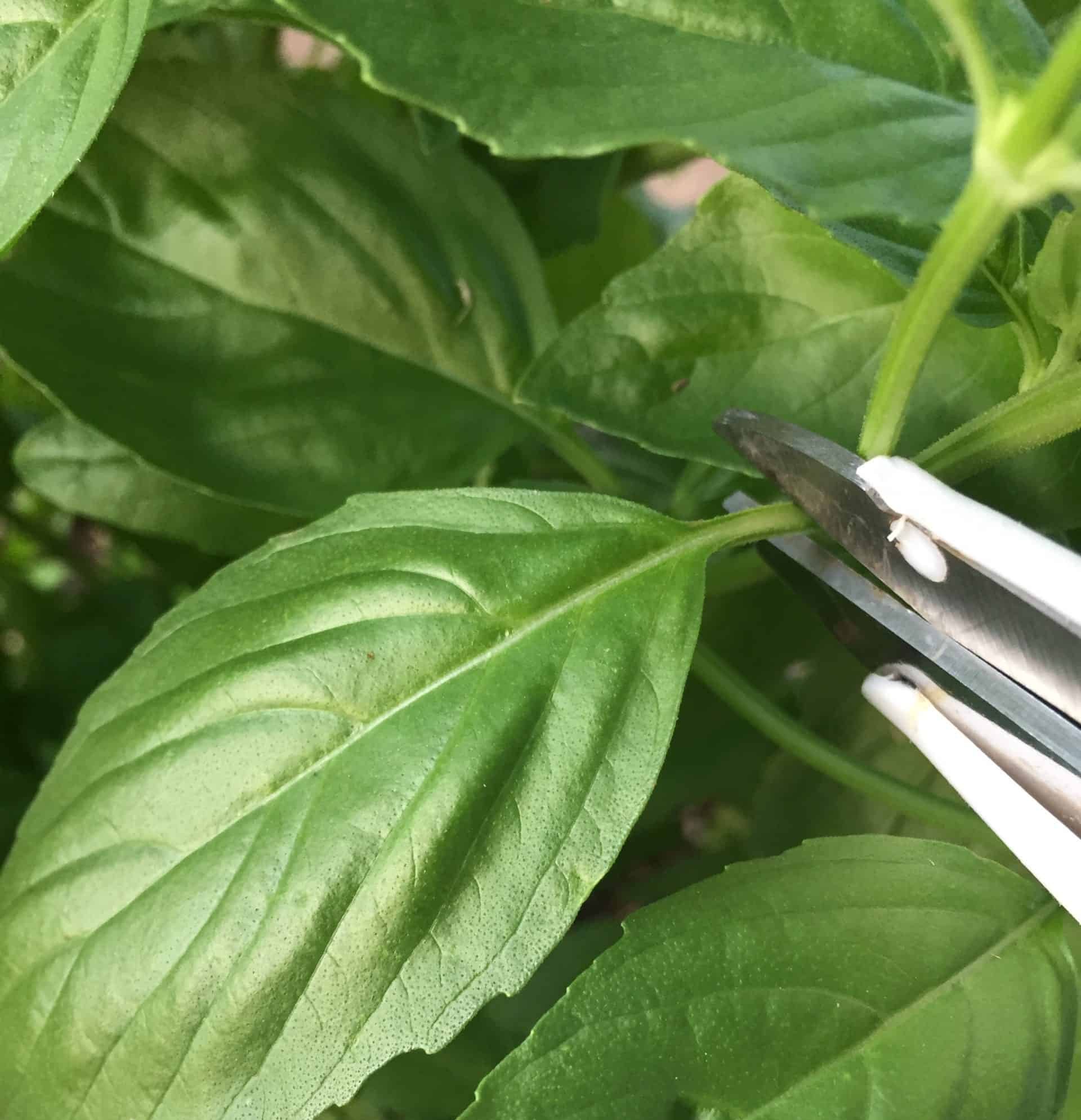Learn how to harvest basil to maximize growth. This warm-weather plant will produce lots of leaves. The great thing about growing basil is you can snip leaves off to use in cooking as well as snip branches off to regrow more basil plants. You can also harvest the flowers and seeds. Before you know it, you’ll have several plants with more leaves than you know what to do with.
There’s no fear of killing the plant when you harvest basil correctly. Picking basil leaves will ensure it keeps growing more basil.
Basil is as popular with gardeners as it is with chefs. It is grown across the world for its flavorful and aromatic leaves. It is relatively easy to cultivate in most climates and endless in its possible uses. Using fresh basil is a surefire way to step up your cooking game.
Understanding how to pick basil is necessary to maintain a healthy plant that produces a steady flow of fragrant and delicious leaves all season long. Here are some of the best tips, including how to know when basil is ready to harvest.
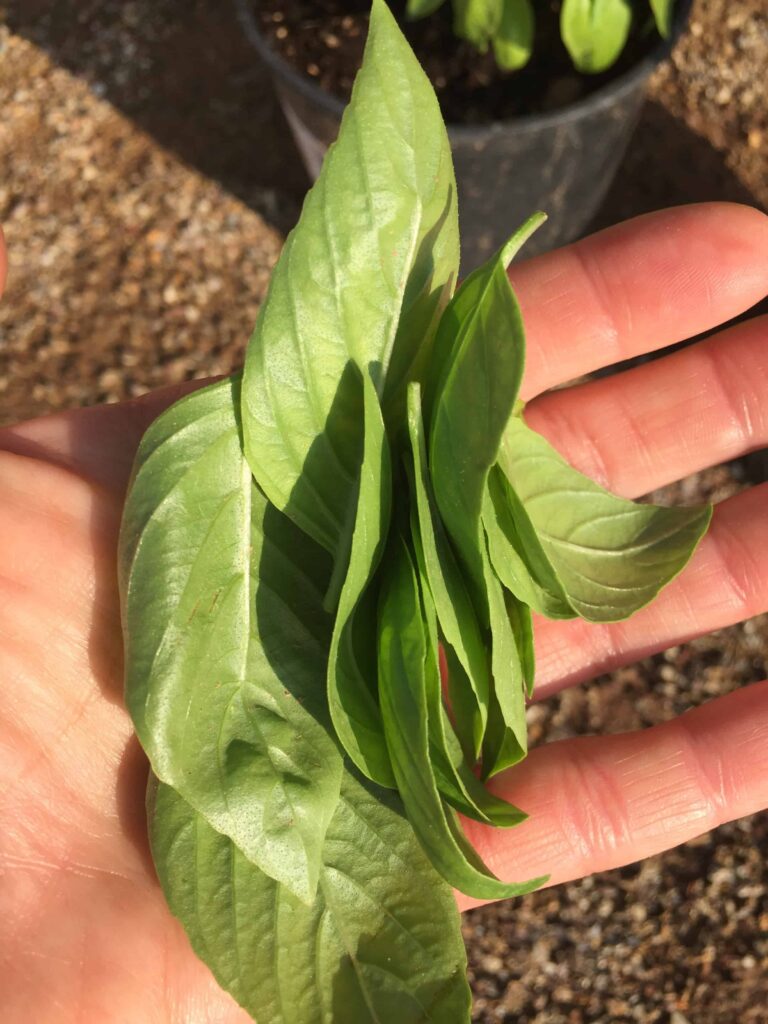
How to Harvest Basil
If you are growing basil from seed, you’ll need to wait close to two months before you can begin harvesting the leaves. You can start picking basil when the plant has three or more sets of true leaves.
If you are growing a basil plant from the store, you can begin harvesting right away. The exception is if you transplant it. You may want to wait a few days to let the plant acclimate. However, it is still okay to pluck a few leaves.
- With scissors, gently snip basil leaves close to their stem
- If using it fresh, cut what you need
- If cutting it to dry for future use, snip leaves but don’t strip entire stems
It’s typically less expensive to buy a basil plant than it is to buy already-harvested basil leaves from the grocery store. It’s especially economical if you harvest it correctly and grow new basil plants.
Pruning Large Basil Plants
When a seedling bears two or three sets of leaves, begin pruning the top center shoot. Pruning, or trimming the overgrowth, is essential because doing so will allow the plant to spend more of its energy on growing new and fresh leaves over and over again.
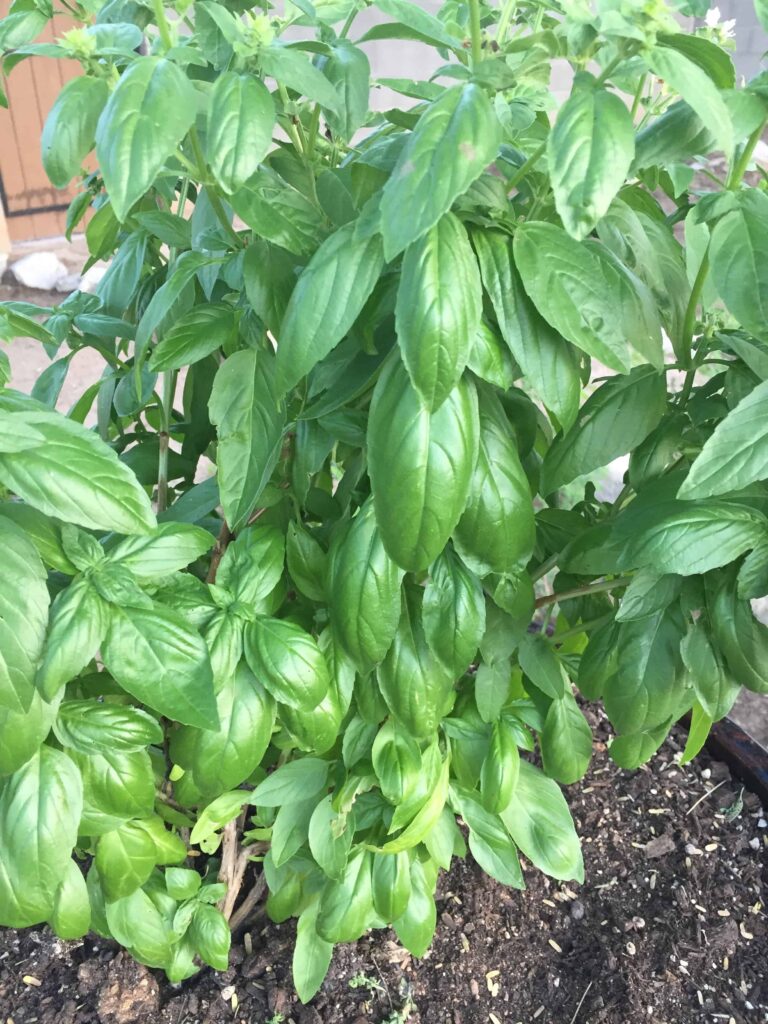
With each cut, one or two branches will grow in their place. Repeating this process for each branch will allow for outward growth, providing a leafier, more abundant basil plant. Whether harvesting fresh leaves or removing wilted and damaged vegetation, pruning basil should be done regularly throughout the plant’s growth.
When to Pick Basil
Regardless if you grow basil from seed or buy an existing plant, once the plant is established, you can harvest the leaves. Experts say to pick basil leaves in the morning when the oil content is the highest. This is also when it’s the most flavorful and fragrant. However, you can harvest basil any time of day and the leaves will still be aromatic and fresh.
There are certain things to consider when learning when to pick basil from the plant. Consider:
- What you want to use the basil for
- Storing for future use
- Picking to use that day
- To grow new basil plants
- When basil plants flower
- Frost and end of growing season
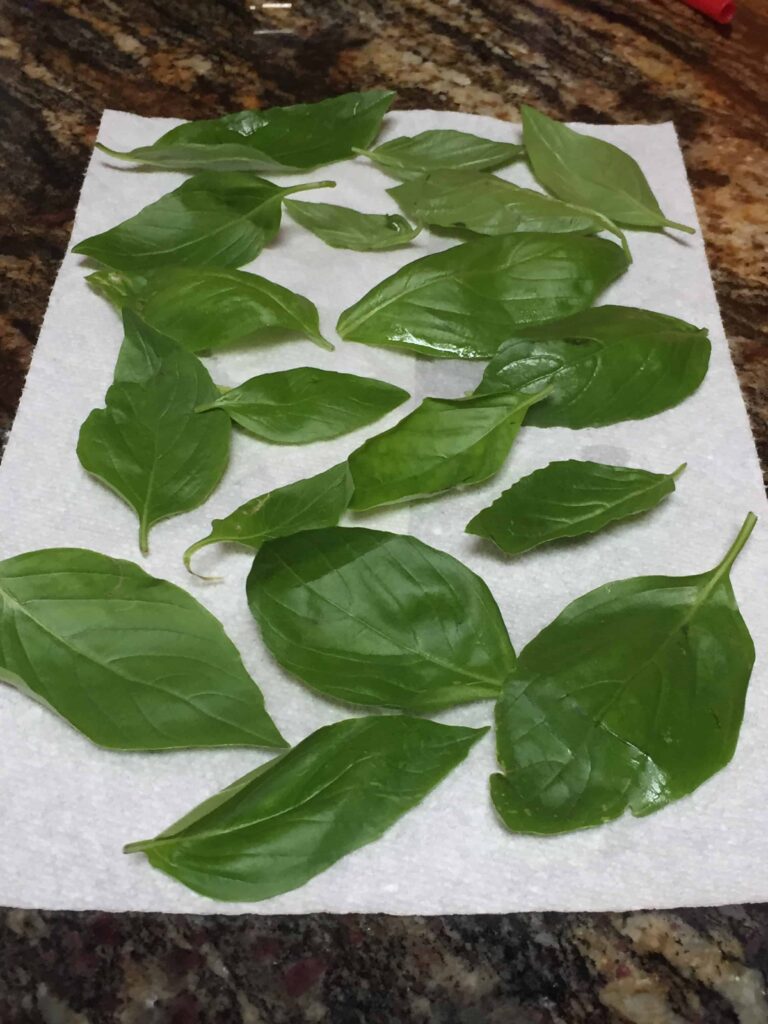
What You Want to Use Basil Leaves For
I have huge basil plants, and I grew them all from one plant. I’ve harvested leaves in the morning, afternoon, and evening. I’ve done this successfully for several years.
Storing Basil
When I want to pick a lot of basil leaves in order to store it for future use, I will plan ahead and harvest them in the morning. Learn how to dry basil to preserve your crop for future use. If I want to freeze basil, I’ll also pick it early in the day, preferably first thing in the morning.
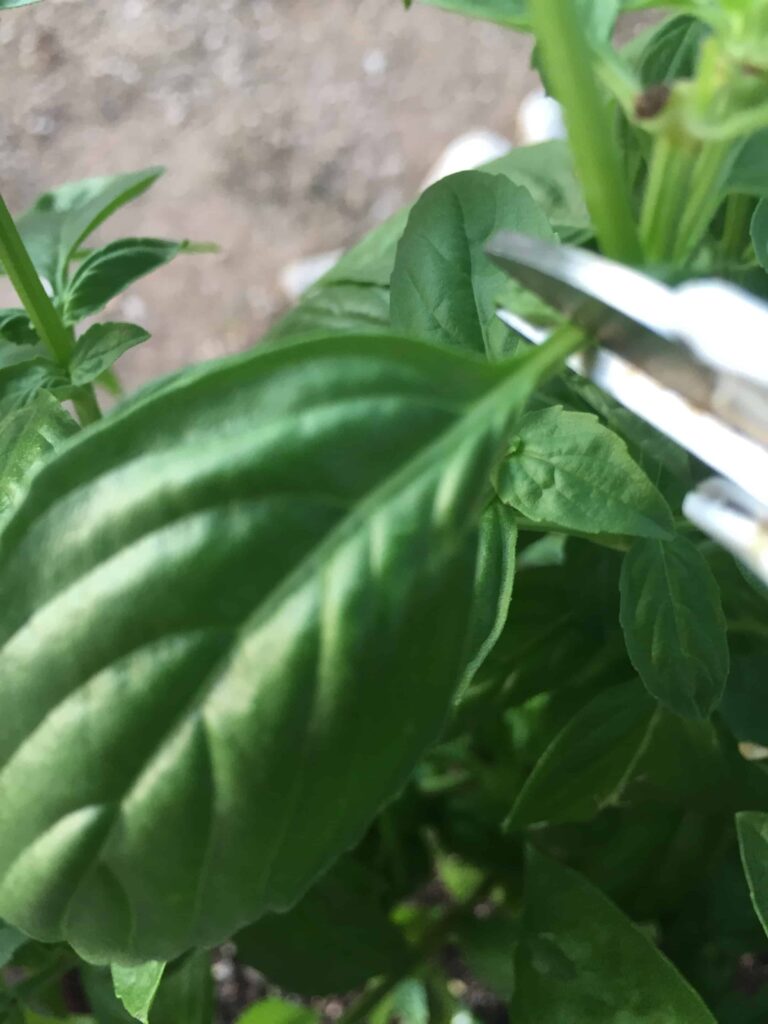
Picking Basil Leaves to Use for Meals
However, when I want to use leaves for cooking or to top pastas and salads, I’ll pick leaves off the plant when I need it. This is usually in the late afternoon, closer to dinnertime… whenever it’s convenient.
I harvest when I need them so the leaves will be fresh, full of flavor and not wilted. I’ll pick the leaves and then just wash and use them right away. There is no prep needed.
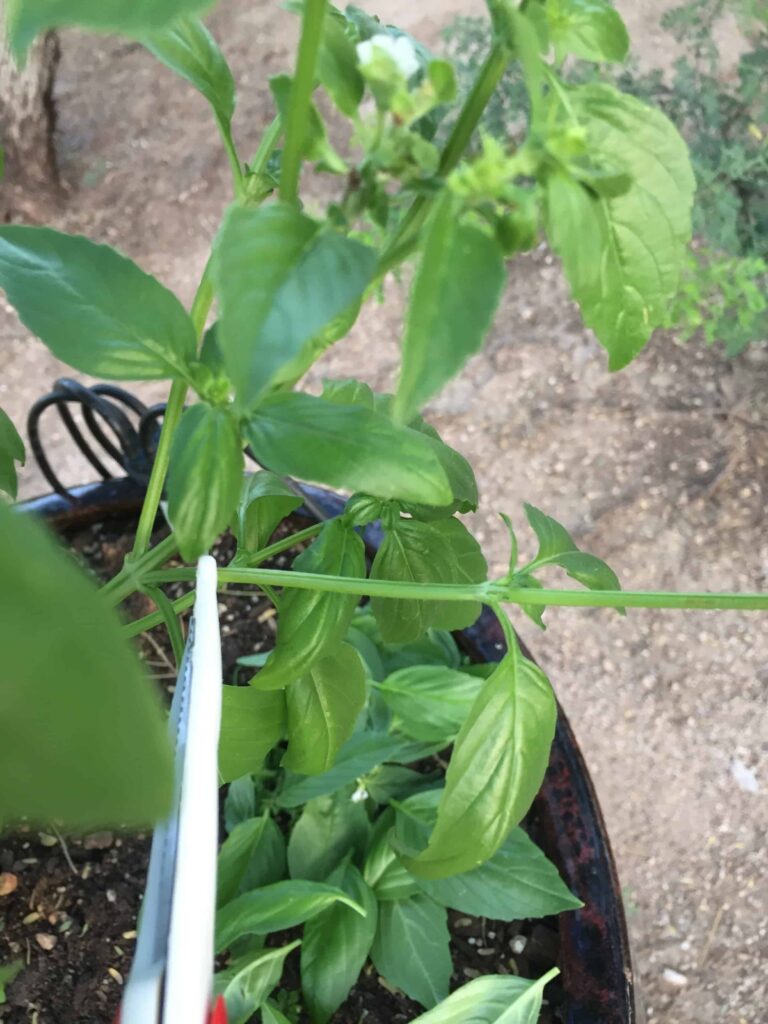
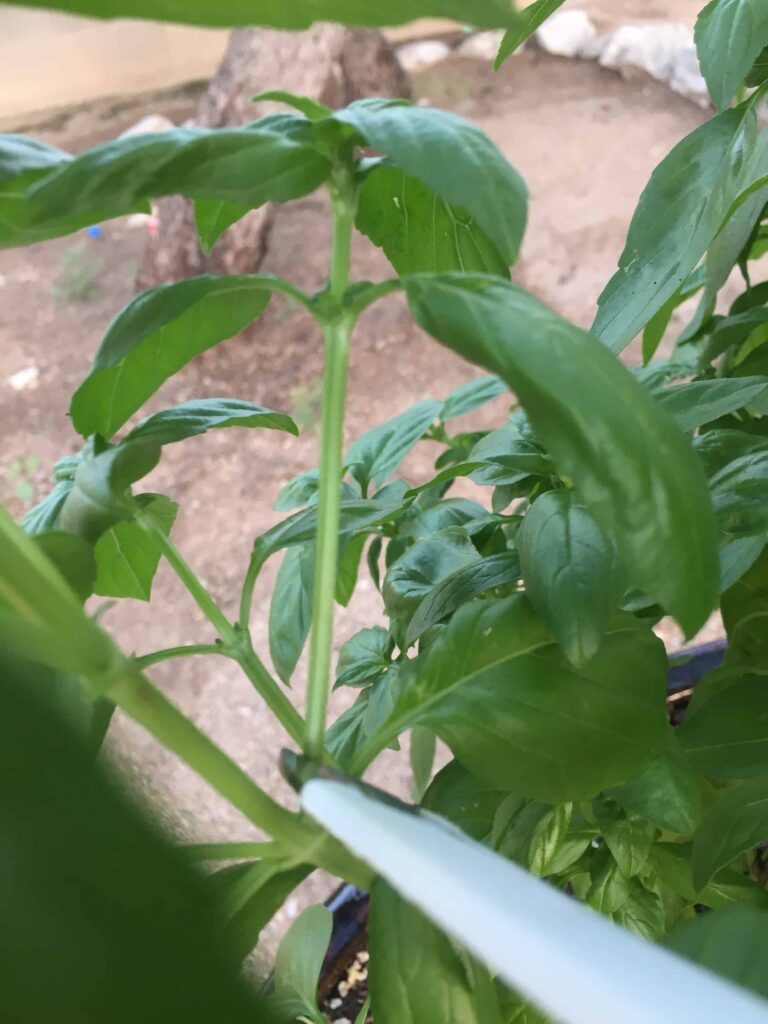
Picking Basil to Regrow New Plants
Harvesting basil to regrow new basil plants is different than picking leaves to store or to use fresh. In this case, it’s important to know how to harvest basil in order to grow more plants. Once the plant is established with several branches, you can gently snip a cutting to root.
If it’s a larger plant, you can snip several branches at a time. Remove and use the lower leaves and put the stems in a glass of water. Change water several times a week.
When the roots are two inches long, you can plant in soil to grow indoors or outside. Soon you will have a new basil plant growing. You can do this multiple times for a mini basil farm.
It’s incredible how many basil plants you can grow from one plant. You can then snip off cuttings from new plants and grow more. Basil thrives in sun and well-draining soil.
It is much faster to snip a basil cutting and root it than growing basil from seed. Though basil is easy to grow from seed; it will just take longer.
Pruning and harvesting from one basil plant can yield many plants. When the new plants grow, you can harvest from them and grow more plants as well.
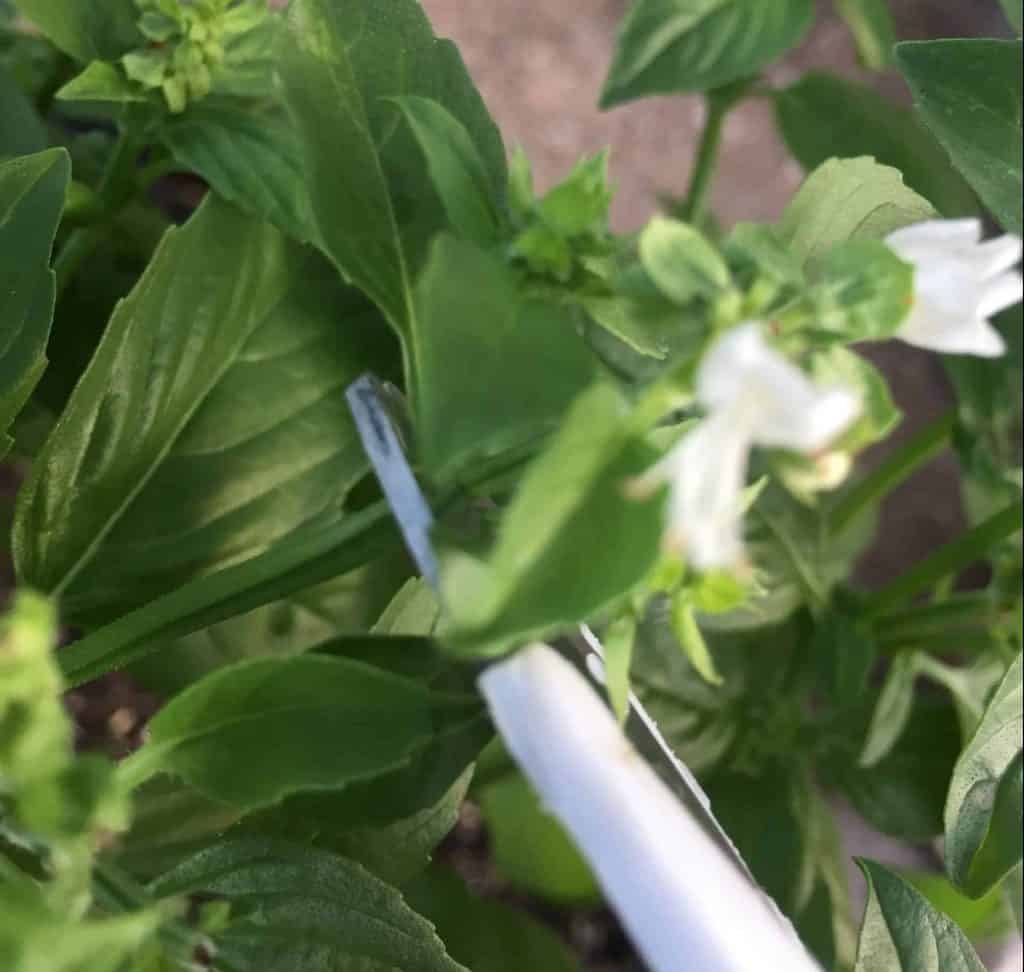
Harvest Before the Basil Flowers and Goes to Seed
You’ll also know it’s time to pick basil when the basil plant begins to flower. You’ll need to snip off the basil flowers as soon as you see them. This is because once basil flowers and goes to seed, you won’t be able to grow more leaves. The plant will die but you can collect the seeds.
Snipping off flowers close to the bud will save the plant some energy, but another flower will likely grow back in its place. Therefore, it’s best to cut an inch or so below the flower. This will encourage more branches to develop instead.
It’s critical to harvest the flowers to ensure the basil plant keeps growing new leaves and branches. Gently snip them off with your fingers or cut them off. Some types of basil with thicker, woodier stems, may be harder to just pinch off. You will need herb sheers or small scissors.
Once you start growing basil plants, you’ll won’t have to wait for the flowers to bloom in order to snip them. You’ll know what they look like and can snip them before they start to bloom.
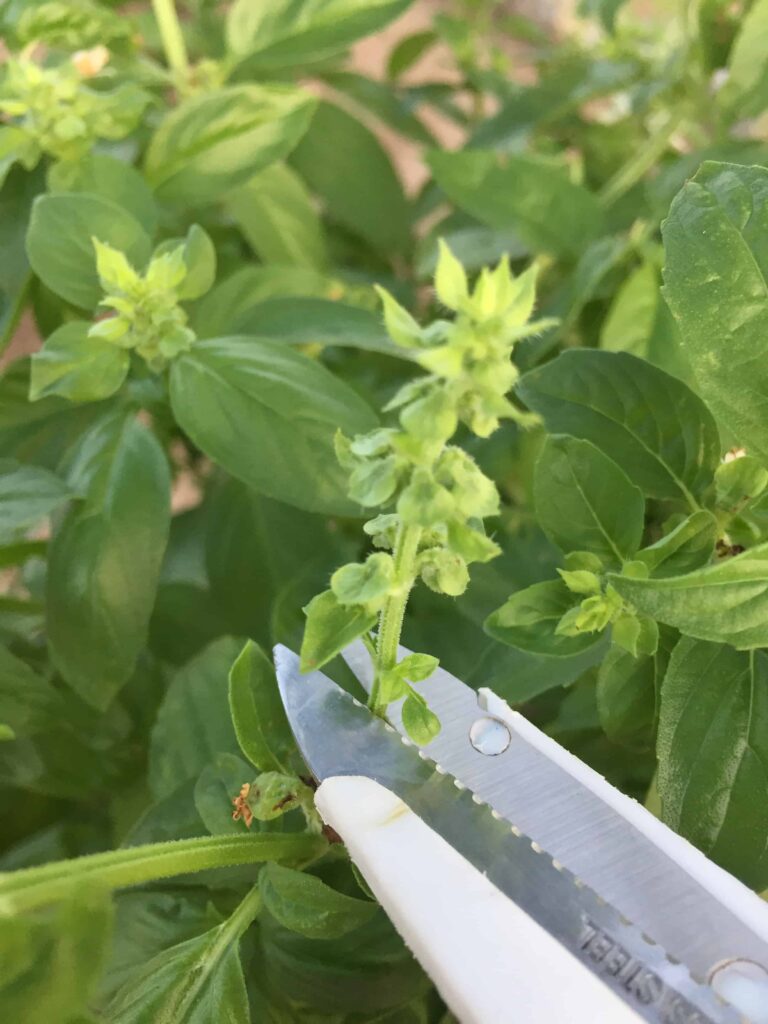
You can also eat basil flowers. They are a delicious addition to pasta with olive oil, delicious in salads, and make a tasty addition when topping poultry dishes.
Barring any other conditions such as over-watering, under-watering, pests, and frost, basil will continue to grow more leaves as long as it doesn’t set seed. Therefore, pluck the flowers and don’t let the basil plant set seed, and it will continue to grow bigger and bushier with lots more leaves.
Harvest Basil Before Frost
Also, consider your climate zone and when your area is prone to frost and freezing temperatures. Basil is a warm weather plant and sensitive to cold weather. The first fall frost will kill basil.
If you live in an area with a moderate winters, you may be able to cover them and grow them for years. Other tender annuals are dill, cardamom, and lemon grass.
When growing outdoors, basil is an annual in colder growing zones. You’ll want to cover basil plants if you expect an early frost. Once it becomes later in the season and starts to turn colder, you should harvest basil leaves.
Basil will die in freezing temperatures, and you’ll need to replant basil the following spring. You can bring basil indoors in the cold months if it’s in a small pot.
Being so sensitive to frost, one must understand what to do before the cold weather arrives. Essentially this means the end of the season. When frost approaches, harvest promptly.
Simply cut the plant stem at the base and pull whatever viable leaves remain. At this point, you need to get the full utility from the plant by using all the leaves. You can also take cuttings to grow indoors.
There’s no worry of over-pruning or over-harvesting at this point. The plant will die eventually with the cold temperatures.
This is also the time to consider if you want to grow basil indoors in the cold months. You can snip all the stems from the outdoor plant and root them indoors. When they grow roots, you can plant them in containers and keep them by a sunny window. You can keep them indoors or transplant them outside after the threat of frost is over or in the spring.
Basil is a perennial in warmer climates. It will go dormant and come back in the spring. If you live in a temperate climate, you can cover the plants to protect from cold weather. In these areas, you won’t need to harvest all the leaves.
If you are growing basil indoors, you should be able to harvest it year round.
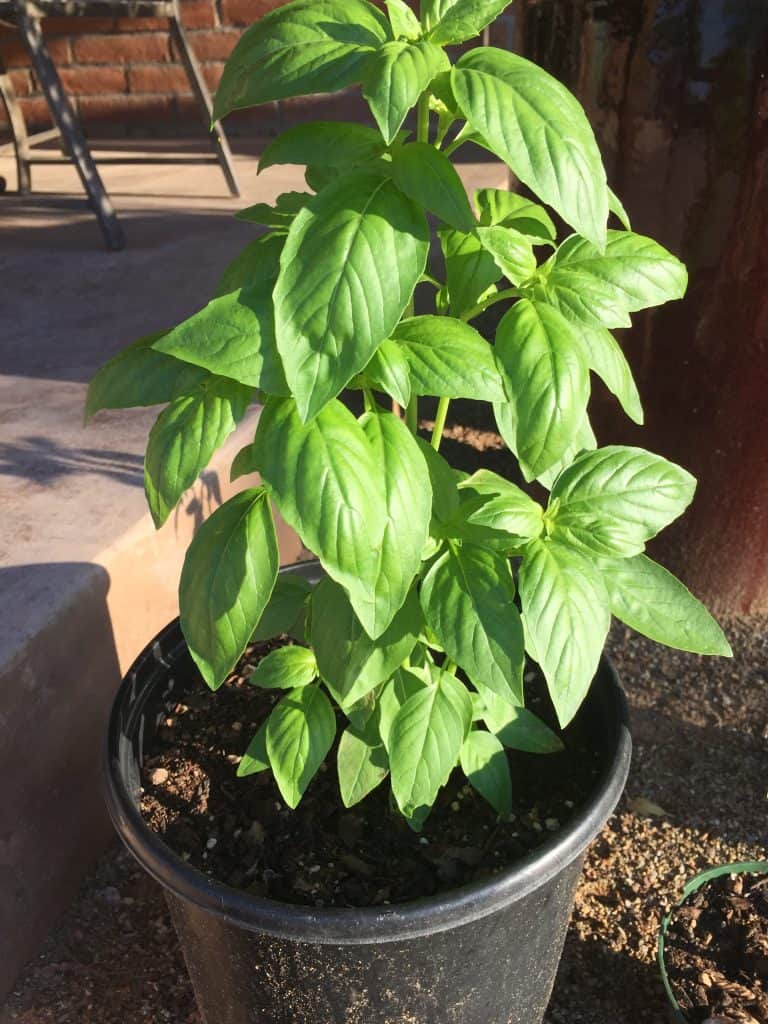
How to Harvest Basil to Grow New Plants
Once the plant has matured, you can snip off branches. These are also called basil cuttings. You won’t kill the basil plant by taking a few stems.
However, if it’s a small plant, you will only want to remove one or two branches from the plant. Snip them off from the bottom. If it’s a larger plant, you can snip several branches. You can also snip one or two branches and then in a few weeks as the plant grows fuller, snip a few more.
Gently remove the branches from the base of the main stem. They should be easy to harvest with your fingers. This will encourage the plant to keep growing new leaves and branches.
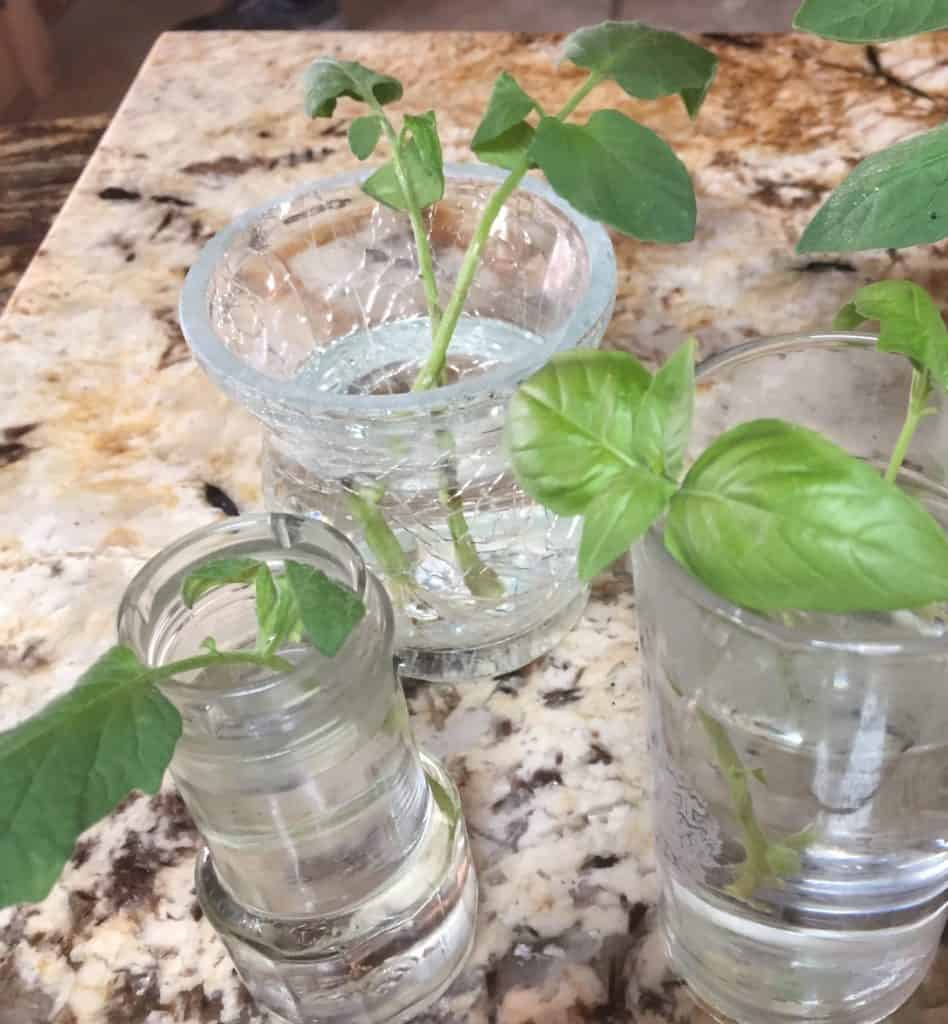
Look for strong stems but be sure you aren’t cutting the main stem. Choose stems that are several inches long.
Once you have snipped off the branches, remove the lower leaves and use them. Place the cuttings in a glass jar filled with water. I use clean glass jars that I would otherwise recycle. Change out the water every few days. Once the roots grow two inches or more, you can plant in soil.
Sow the rooted cuttings in moist soil. The soil should be damp, but not saturated. Basil plants prefer six to eight hours of sunlight per day but can thrive under less than optimal sun exposure.
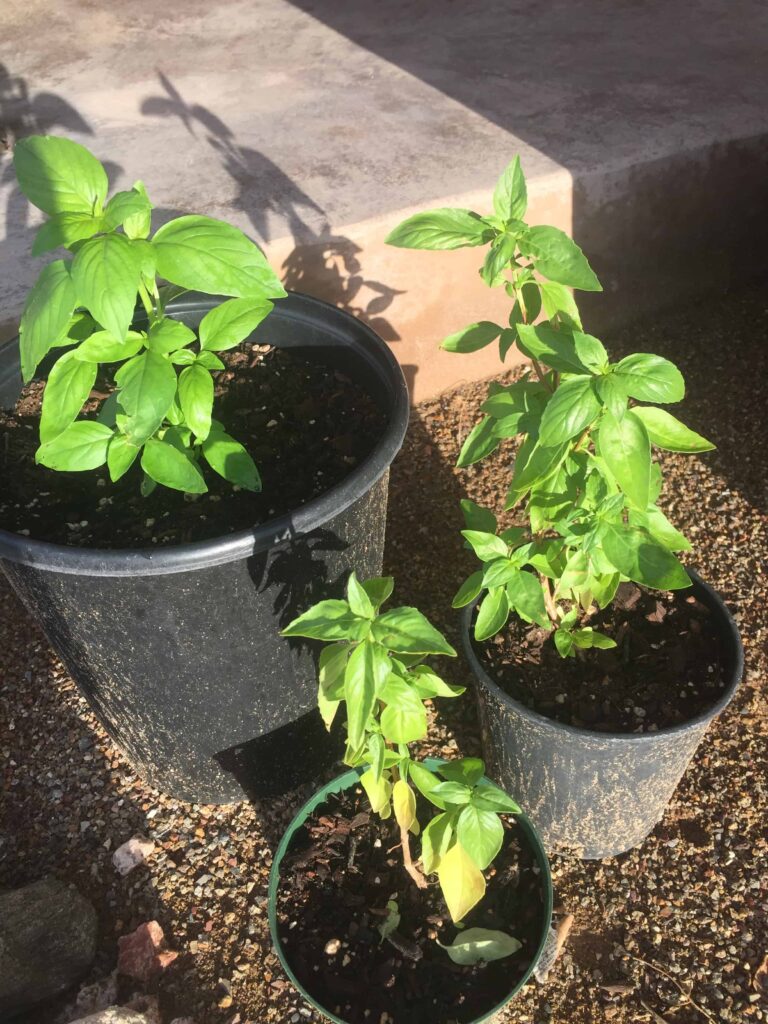
Growing Basil from Basil Cuttings
It is usually a good idea to plant basil indoors before transitioning it outdoors. You can continue pruning stems all spring, summer and fall to grow new basil plants. If you take cuttings to regrow in the fall, you may want to grow them indoors unless you live in a temperate climate.
Starting the process five or six weeks before the last spring frost will put the basil on schedule for the summer season.
Once the new plant produces at least three sets of leaves, and the outdoor temperature remains above 60 degrees, it is safe to transplant to the garden or a container outdoors. Plant them about 12 inches apart, giving them room to grow big and bushy.
Ultimately, most basil plants will achieve a height of 12 to 24 inches. As temperatures approach 80 degrees F, the plant will become dense with foliage. You’ll have lots of leaves to harvest.
If the harvest is for cooking, be mindful of where it is to be planted to avoid exposure to pollution, unwanted chemicals, or pests.
How Often to Harvest Basil
Picking basil leaves regularly will ensure it keeps growing. Even if there’s no immediate use, you can harvest the leaves by drying or freezing them. Consistent harvesting will maximize the yield over the plant’s life cycle. You’ll know basil is ready to pick when you see lots of leaves. Snip the larger ones. In a few days, snip some more.
Where Do You Cut Basil When Harvesting
When the plant is new, you’ll want to pick basil from the bottom rather than the top. These will be the larger leaves. As the plant becomes established, you should continue picking the largest leaves.
Cut basil leaves at the stem close to the branch. You will be able to snip them with your fingers. Some gardeners advise cutting with shears rather than hand plucking basil leaves from their branches.
Pulling at the leaf risks damage to the stem, compromising further growth. However, you can easily snip basil with your fingers using your thumb and forefinger. Just take care when removing each leaf so you don’t damage the stem.
When you cut basil stems to grow new plants, you want to cut them close to the main branch so the stem is as long as possible. You want to be sure you don’t damage the main stem.
Again, you should be able to do this with your fingers. However, if you are harvesting a lot, you may want to use small scissors. You can also use herb shears or small gardening shears.
How Much to Harvest
It’s all about the recipe and the plant. Whether making pesto or garnishing a dish, the harvest’s size depends on how much is needed and how large the basil plant is.
For smaller yields and smaller plants, pick the leaves from the top down. Make cuts just above the node. A node is an intersection between two branches.
With larger harvests, it is acceptable to cut a more significant portion of the branch or stem. In this case, one could get away with cutting the plant down to about a third of its total height. As long as the cuts are clean and made to promote further branching, the plant will continue to grow and produce more leaves.
How to Harvest Basil Seeds
If you want to harvest basil seeds, allow the basil to flower. After pollination, the flower will appear to fade. The seeds are within the spent flower. Harvesting them is a matter of picking the flowers, allowing them to dry, and separating the seeds from the head.
The easiest way to do so is to crush the dried flower over a strainer fine enough to let only the seeds fall through or else manually sift out the seeds from the flower matter.
If you are growing basil in a large container or planter, you can also let the flowers go to seed and gently shake out the seeds into the pot to grow. Cover them with soil and water. In this way, you will always have new plants growing. This works well for Italian parsley as well.
Harvesting basil seeds is a great way to prepare for the next season. If a crop comes out exceptionally well, saving the seeds will guarantee access to the same genetics that performed so well this season. (Instead of harvesting seeds, you can also snip several branches to root and grow indoors throughout the winter.)
Understand that basil can cross-pollinate between varieties. To avoid unwanted hybridization of seeds, leave ample space between grow spots of each different type.
Basil seeds are edible too. High in health-promoting plant compounds and low in flavor, basil seeds can be easily incorporated into many recipes or used as an alternative to other edible seeds like sesame or chia.
Picking Basil
We put in our sauces, cook it with meat and fish, use it in salads, cocktails, ice cream, curries, and of course pesto. There is little that you cannot do with basil.
Harvesting basil is an excellent way for novice growers to be successful gardening. It is a simple and robust plant that grows quickly and well when you harvest correctly. It allows gardeners to realize the benefits of growing fresh herbs at home.
Basil is a crop that has been cultivated and enjoyed for thousands of years. Adding basil to one’s gardening portfolio is an enjoyable project that yields an infinitely valuable and delicious food celebrated worldwide.
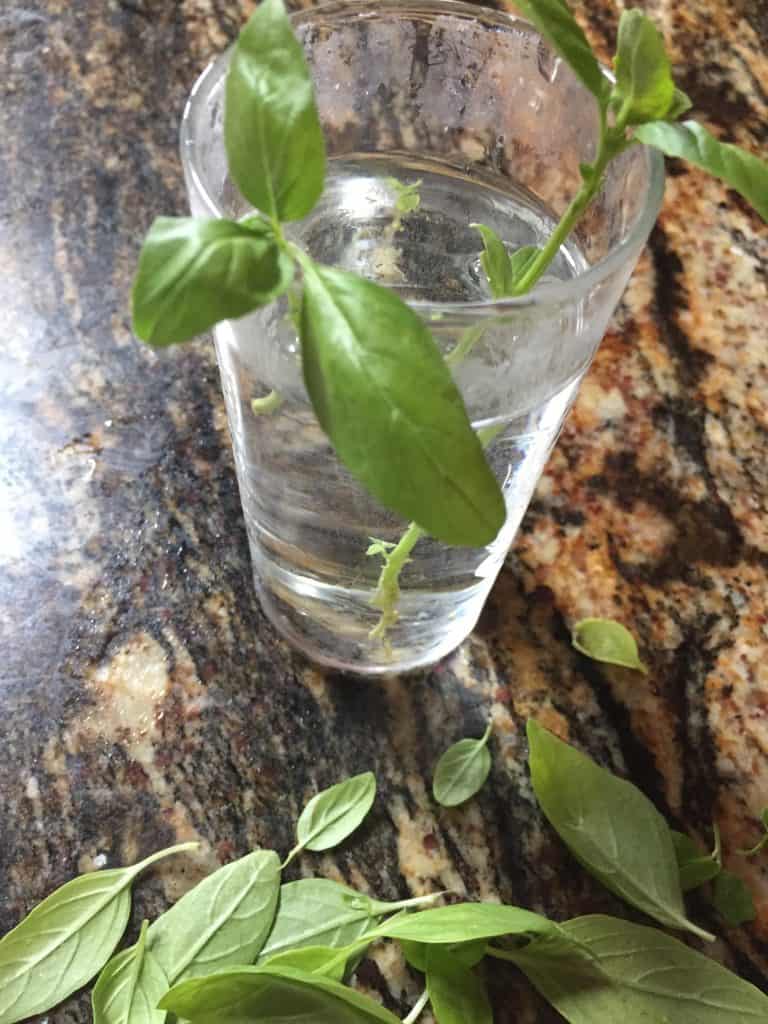
Harvesting Fresh Basil So It Keeps Growing
When you harvest basil correctly, you’ll grow lots of basil. Then the problem becomes, what to do with all the basil you pick?
In addition to using fresh leaves to top meals, you can add it in the last few minutes of cooking.
To get the most shelf life out of freshly harvested basil, you can easily dry basil. Freezing basil is another option. You can put the leaves in a plastic bag or freeze them in ice cube trays with olive oil.
You can also use basil to make preserves or infused oils. It’s another great way to enjoy the fruits of labor well after the growing season has ended.
It’s also fun to harvest the stems with leaves and give them to friends. They can use the leaves and root the stems to grow their own plants.
The great thing about harvesting basil is the more you harvest it, the more it grows.
Picking Basil Leaves
Regularly harvesting basil is a way to keep the plant growing well. The more you pick the leaves, the more they will grow. Most people agree that growing basil is straightforward. It is an annual herb of the same family as other kitchen staples such as thyme, mint, and rosemary.
Basil thrives during the summer season, preferring moist, well-drained soil and ample sunlight. It is commonly grown both in and outdoors and will thrive and continue to grow as long as you harvest it regularly, being sure to remove the flowers.
As an annual plant, outdoor basil will produce vegetation only for a short time in most climate zones before reaching maturity. Basil is highly frost-adverse. Once exposed to freezing temperatures, the plant will die off.
There are several types of basil, each with a distinct taste and smell. Whether you are harvesting sweet basil, Thai basil, lime or lemon basil, the method for picking basil off the plant is the same. The only difference is if the stems are woodier and thicker. You may need to harvest leaves with small gardening shears or scissors.
Growing herbs such as homegrown basil is a way to be successful without spending a lot of money on gardening. You’ll have a good harvest while enjoying flavor from your garden. It’s also an herb that grows well outdoors in most climate zones. It doesn’t take up a lot of room, making it ideal for a mini garden on the balcony.

